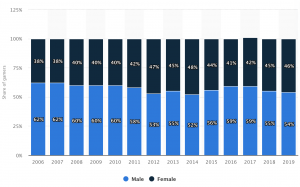Gender in Video Games
Gender in Video Games refers to the portrayal and representation of gender and gender identities in characters created for the video gaming medium. While gaming as both a medium and culture has changed drastically over its history, the content that it contains has evolved to accommodate not only new technologies as they are invented, but to also cater to the social environment and audience. Many feel that the very nature of video games allows them to become a brief escape from reality, giving players the chance to live fantastical lives outside of their own. Outside of the purview of sports games where play is strictly based on real world people and human attributes, many of these games facilitate the story they tell by using fantastical characters, even those who's worlds are based in reality.
Contents
History
While not expressly contributing to how gender is represented in the video gaming market, the history of video gaming plays some role in how gender is represented. While the history of electronic gaming itself spans nearly 50 years when home consoles such as the Magnavox Odyssey were released back in the early 70's, the true heyday of gaming didn't start until the release of the Famicom in Japan, and the Nintendo Entertainment System (NES) to the US and the rest of the world in 1983. While gaming was originally marketed as a family activity for children and adults of all genders and ages alike, after the video game crash of 1983 Nintendo's new home console was marketed primarily toward boys as a toy, and the gendered marketing tactics of the 80's forced the company to choose an audience to cater its marketing toward. Subsequent consoles of the era followed suit and soon video gaming was seen as a hobby for boys.
In its early days, large cabinets were needed to produce the improved graphics desired by players over those of the home consoles, and arcades were the dominant place to socialize and enjoy these benefits. Since many gamers who would go to enjoy their pastime were much more often young adult men and boys than girls or women of comparable age, this affected the representation of gender in the games themselves since designers were not only looking to make a great game, they needed one that would appeal to the largest possible audience. As a pioneer of the medium and still active creator Shigeru Miyamoto states in an interview with Kotaku regarding the development of the 1981 game Donkey Kong : "back in the days when we made the first Donkey Kong, that was a game we first made for the arcades, the arcades were not places girls went into often. And so we didn't even consider making a character that would be playable for girls."
While this would remain true for many years to come, the rumblings of diversity and gender representation through gaming would begin in this new console form for the medium. In 1986's hit title Metroid for the NES it would be revealed to the player, upon completing the game in a specified amount of time, that the strong, defiant, lone-wolf hero character they had been playing throughout the adventure was in fact a woman in a suit of armor. While this was a shock to many players, it by no means shifted the video gaming culture at large, and in fact much of the gender based controversy in gaming to come would take place in the decades to follow. The reveal of Samus Aran would, however, serve as one of the first instances of a strong female protagonist in video gaming, and through much of the following controversies and even the growing number of characters in gaming, Samus Aran remains one of the most popular and respected characters in video games to this day.
Overview of Player Base
A lot of how characters are represented in any published medium has to do with the audience who consumes the content, and the ways in which sex and gender have been expressed in video gaming has been due in no spall part to said audience. While video gaming as a platform for published content is quite young in comparison to other popular forms of entertainment such as books and magazines, and even in comparison to other forms of pop culture such as music, comic books, and film, it is hard to understate its impact on culture today. In 2018, nearly 2.7 billion people worldwide played video games, and those who identified as gamers accounted for 66% of the US population alone. While the medium has traditionally been seen as having a player base that largely identifies as male, today in the U.S.
The difference is much closer to a 50/50 split, as in 2019 it was reported that 46% of the population claiming to be part of the gaming community identified as female. With the player base being so close to an even split today, the market has been slowly shifting course to express views that are more in line with those of the culture and its views on gender today, but it is important to understand the history of gaming and how it has shaped its characterization of gender in the years and decades prior.
Identifying With the Character
These characters are designed to be identifiable by the player in some way, While game designers are often looking to real world examples to further flesh out the content of their games, and the intended social consequences of their work is most often benign, the prevalence of the medium dictates that regardless of intention they have unintended consequences. These include the ways in which people see themselves who are from the societal, economical, racial, and gendered demographics that are represented by these images. While all depictions that negatively affect the image of those disparaged should not be overlooked, the most hotly contested representations in our culture today derive from those of gender.
Gender Expression in Video Games
References
Gough, Christina. “U.S. Video Gamer Gender Statistics 2019.” Statista, 3 July 2019, www.statista.com/statistics/232383/gender-split-of-us-computer-and-video-gamers/.
Fuller, Steve. “U.S. Gamers.” www.statista.com, www.statista.com/topics/3070/us-gamers/.
Totilo, Stephen. “Shigeru Miyamoto and the Damsel In Distress.” Kotaku, 20 June 2013, 2:45, https://kotaku.com/shigeru-miyamoto-and-the-damsel-in-distress-520259897.

